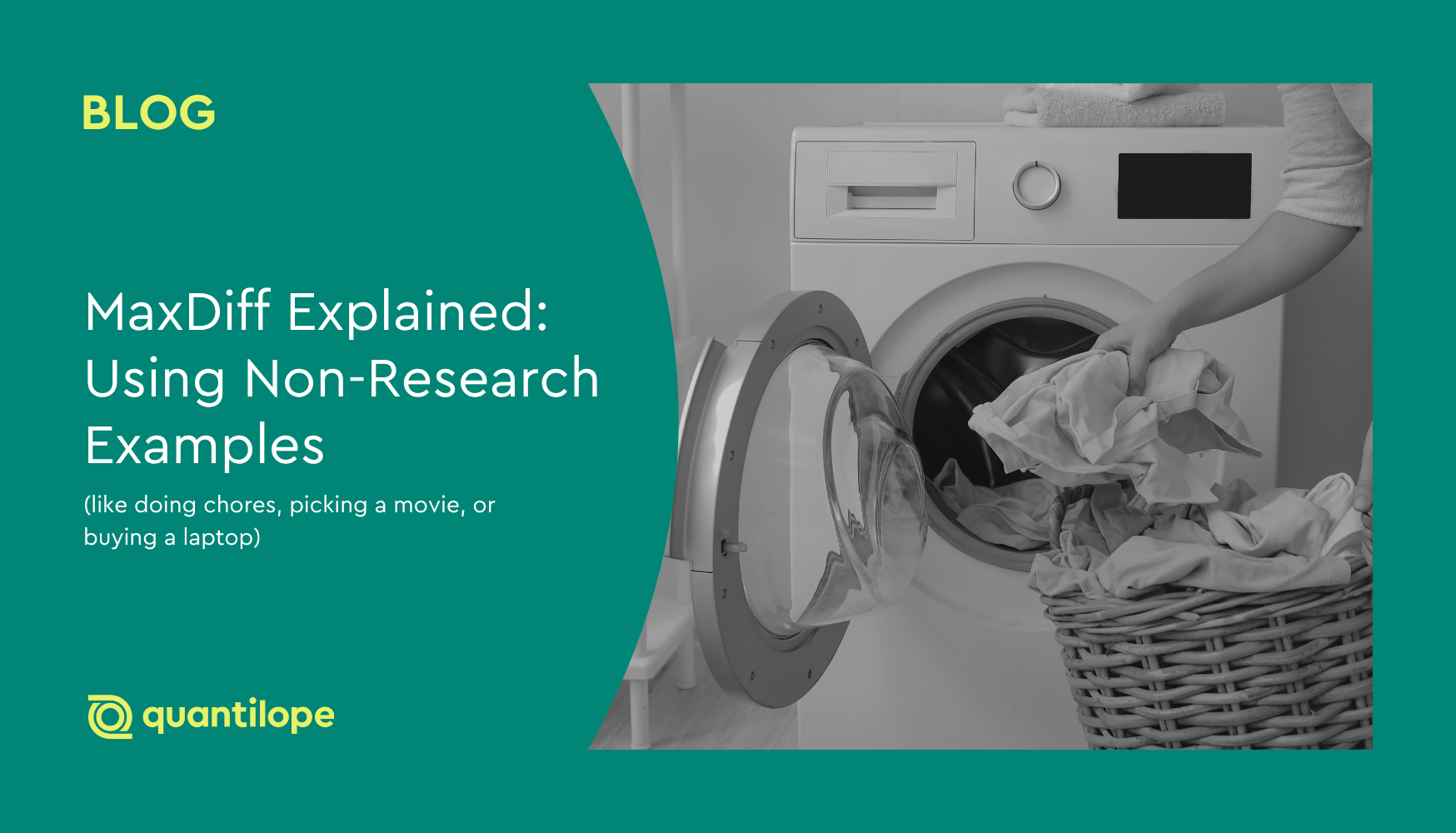This blog post looks at the rationale for conducting market research, as well as how market research survey templates can ensure your research is thorough and insightful.
Table of Contents:
- Understanding the purpose of market research surveys
- Types of market research surveys
- What should you include in your market surveys?
- What is a market survey template?
- quantilope market research templates
Understanding the purpose of market research surveys
Any business that wants to make its offer relevant to customers will need to understand what its customers think and want. This means listening to those customers in the form of market research. Researching your customer base helps you to...
Make better business decisions
There’s never any shortage of business decisions to be made, whether it’s knowing when to expand the business, cut products from the shelf, launch new products, tweak price points, change packaging design...the list goes on. These decisions need to be informed; if you don’t know what your customers are thinking, you’re not making the best use of your resources. Knowing who buys your product or service involves building a profile of who your customers are, what their attitudes are, and how they behave so that your business decisions are based on data-tested hypotheses and solid predictions.
Improve existing products and services
Gathering customer feedback needs to be central to getting to know your target audience; knowing your target audience helps you tailor your product or service to closely match their needs. If you have data that says your laundry detergent is sold at a great price but it doesn’t remove stains as well as a competitor, you know you need to work on its formula. If the price and formula are great but it drips all over the floor when it’s poured into the washing machine, the packaging needs some attention. Without customer insights, you won’t know where to focus your efforts (and your budget).
Understand what drives customers to purchase certain products
If you know your target market’s motivations, you can put yourself in your customers’ shoes. Understanding why they choose one product over another product highlights which elements of an offer are most and least important, and how these preferences stack up to your brand specifically. Mapping the market - aka, understanding the category and where your brand fits - shows where opportunities lie and what your brand needs to do to gain maximum market share.
Back to Table of Contents
Types of market research surveys
Anything and anyone that impacts the way your business runs can be researched - from actual products to pricing strategies, consumer behaviors, or even suppliers. The subjects of surveys are too numerous for them all to be listed here, so here are just a few examples.
1. Understand buyer personas
Nailing down who your consumers are is crucial to an effective marketing strategy. Surveys will establish demographics (age, gender, location, social class, etc.), attitudes, needs, and behaviors. These are often done using segmentation studies, which group a brand’s target audience or customer base into different groups of people who share product/service needs.
2. Measure the impact of price changes
Getting pricing right is a key element of a product’s success. Specialist pricing models (such as Van Westendorp/PSM) present respondents with different price points for a specific product to identify which are perceived as too cheap and which are too expensive, relative to the quality of the product. This type of pricing analysis reveals the optimum price point - the one that will attract the highest number of buyers.
3. Explore the customer experience
Understanding how consumers use your product or service means you can keep on top of their needs, even if they change. This includes researching when, where, how, and why they use the product or service, tapping into motivations, behaviors, and attitudes that guide brands on how to optimize their offer. This kind of research can be done in relation to existing products as well as new product concept testing, idea screening, and package testing. They might be one-off products to inform product strategy or regular customer satisfaction surveys to keep tabs on where to direct improvements. Tools such as an NPS (Net Promoter Score) can gather insights into general customer satisfaction by directly measuring how likely consumers are to recommend a company, product, or service.
4. Understand your brand
The way you see your brand might not be the way consumers do. Brand awareness surveys will reveal who knows your brand, while purchase behavior might reveal a totally new story. Perhaps a survey reveals that usage and satisfaction rates are high, but consumers are using or your brand in a way you hadn’t predicted. Surveys that explore your brand’s image, where it is positioned in the competitive set, how well it is doing, and how its performance changes over time will help you keep ahead of the competition and maximize customer retention.
5. Research internal operations
While much of market research is externally facing to consumers of a product or service, many companies use research to ensure their internal organization is just as healthy as its brand image. Questionnaires are distributed amongst staff to gather anonymous feedback on various aspects of the organization and its processes. Such findings help guide HR policies, improve working methods, and keep staff motivated.
Back to Table of Contents
What should you include in your market research surveys?
The actual survey questions that go into a research project are as varied as the types of surveys that exist. Depending on what aspect of your product or service you are researching, you might want to include questions around:
- purchase behavior
- usage behavior
- attitudes (towards a brand, product/service, category, etc.)
- met and unmet customer needs relative to a product, service, or brand
- perceptions of a brand
- reactions to a new product concept, design, logo, packaging, or any other stimulus you’d like to test
Fundamental to all surveys is an understanding of the demographics you are sampling and how answers differ depending on those demographics. As such, there should always be questions about age, life stage, gender, location, social class, and anything else that helps classify who your consumers are.
Back to Table of Contents
What is a market research survey template?
Whatever the type of survey you are conducting, the likelihood is that someone else has conducted a similar survey in the past. Surveys with the same theme tend to contain similar questions, and therefore can cut down a lot of prep work. This is where market research survey templates come in.
A market research survey template contains pre-programmed questions that a user is likely to want to include in a particular type of research. For example, if you want to conduct a segmentation exercise, you will need to include a vast array of questions about usage, behavior, attitudes, and demographics. If you are looking for customer feedback on a specific piece of messaging or product features, you will want to include questions on appeal and understanding.
A good questionnaire template based on the research problem will save the time needed to create the questionnaire from scratch, yet will be flexible enough to allow customization by changing the wording of questions, removing unnecessary answer choices, or adding questions according to the needs of your unique research objective.
Back to Table of Contents
quantilope's market research survey templates
quantilope’s expertise in a broad range of research has led to the creation of multiple market research survey templates that make launching surveys easier than ever. These templates, which are directly built into the platform, include the core questions for different types of research studies (i.e. brand health template, product idea screening template, etc.). Users can simply select the template that corresponds to the type of research they're looking to run, with the option to further customize however they wish.
With this new addition of templates, quantilope users have more flexibility than ever when it comes to streamlining their research. Whether a researcher opts to start from scratch by picking and choosing certain questions to drag & drop into a survey, or use a template as a base with automatically-generated questions for various types of research, the option is theirs. Regardless of the survey's setup (from scratch or using a template as a base), all thirteen of quantilope’s automated advanced analysis methods are available to drag+drop into the study as well, including complex methods such as Conjoint, Segmentation, TURF, and more.
Whether you need to test a product concept, optimize your product portfolio, understand your brand positioning, or explore a variety of other business issues, quantilope’s market research survey templates will streamline your data collection so that you no longer need to worry about which question types to ask or which analysis tools to use in order to get the answers you need. quantilope’s templates not only allow for peace of mind that a survey is correctly set up, but they can also be leveraged quickly to avoid bottlenecks or tedious tasks, and are standardized to ensure a question is asked in a research-backed format.
“Giving confidence to our clients is at the core of our work. They need to be sure they can gather customer intelligence in a quick and actionable way without breaking their budgets. Our new templates are taking this one step further” – Katharina Weiß, Director of Customer Success
To find out more about how quantilope’s market research survey templates can add value to your research, get in touch below:




.png)